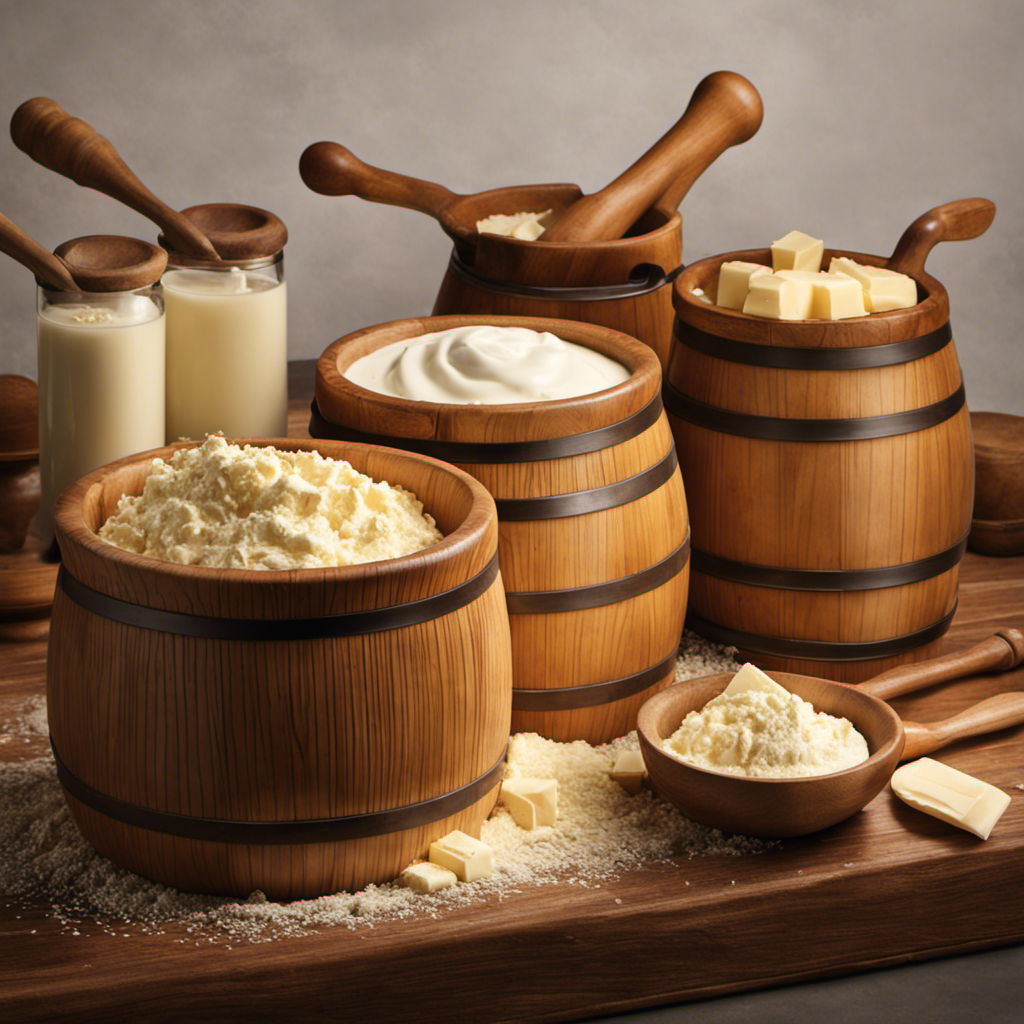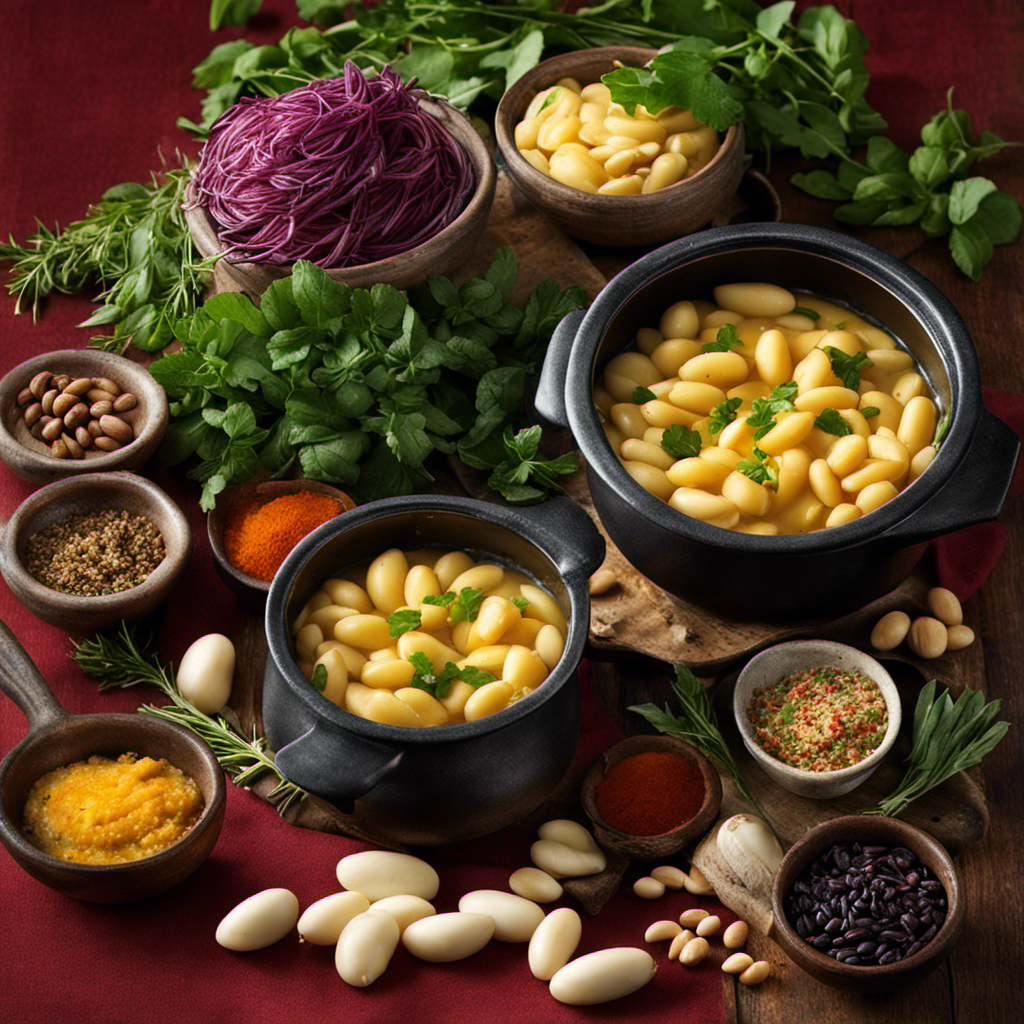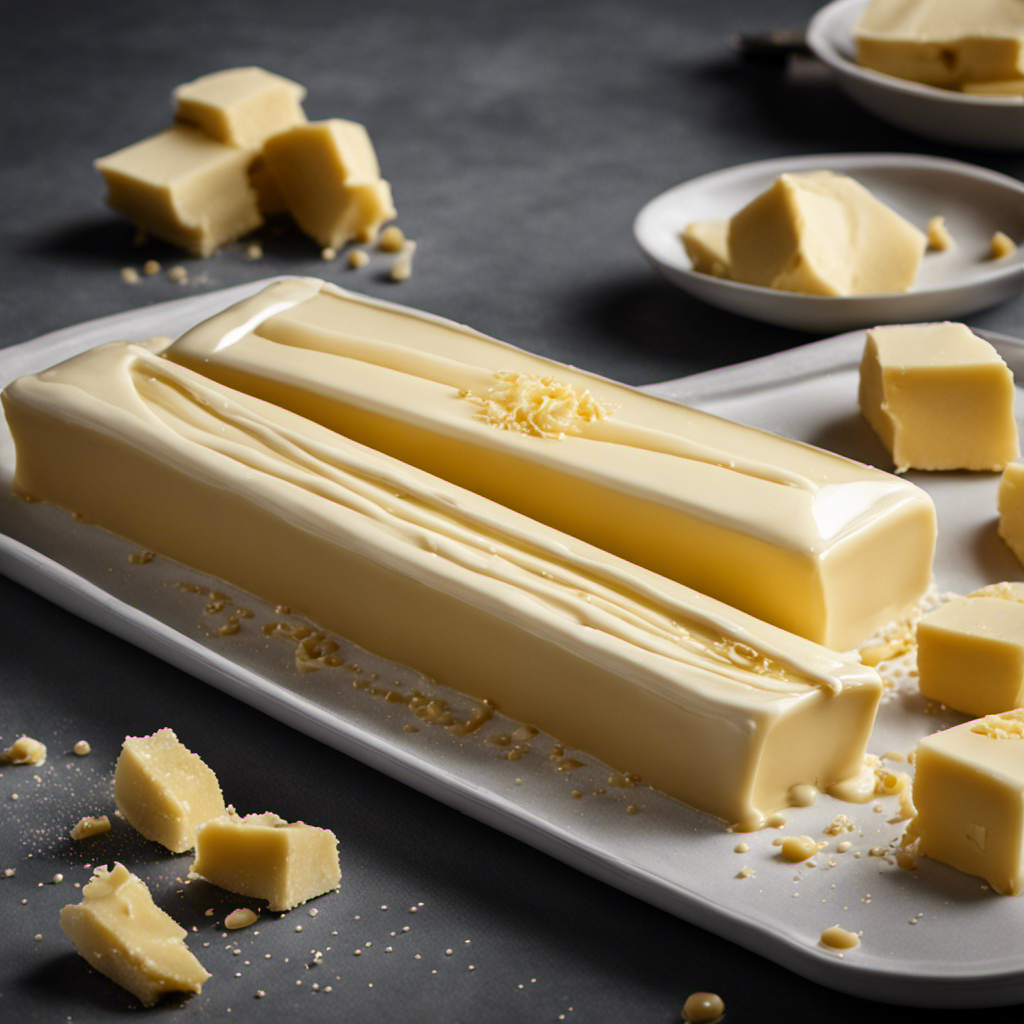As someone who is passionate about butter, I frequently catch myself contemplating the longevity of the butter I make at home. It’s a fragile balance of staying fresh and avoiding spoilage, as the lifespan of homemade butter is affected by numerous elements.
In this article, I will delve into the secrets of butter rancidity, proper storage techniques, and tips for extending its shelf life.
Join me on this journey as we explore the world of homemade butter and learn how to savor its creamy goodness for as long as possible.
Key Takeaways
- The freshness of ingredients used affects the quality and shelf life of homemade butter.
- Proper storage techniques, such as refrigeration at a consistent temperature and using an airtight container, can help preserve homemade butter.
- Exposure to air, light, heat, and moisture can cause butter to become rancid, so it’s important to store it properly.
- Signs of spoiled homemade butter include a sour odor, yellow or brown color, and changes in texture. It is recommended to use homemade butter within one week for optimal taste and quality.
Factors Affecting Homemade Butter Shelf Life
There are several factors that can affect how long homemade butter is good for. The quality of the butter is influenced by various factors, such as the freshness of the ingredients used. Using fresh, high-quality cream is crucial in producing butter that has a longer shelf life. Fresh cream contains fewer impurities and has a lower bacterial count, which helps to preserve the butter for a longer period.
Additionally, the temperature at which the butter is stored plays a significant role in determining its shelf life. It is important to keep homemade butter refrigerated at a consistent temperature to prevent spoilage and maintain its quality.
Understanding these factors is essential in ensuring that homemade butter stays fresh and delicious for as long as possible.
Transitioning into the subsequent section, it is also important to understand the concept of butter rancidity and how it affects the shelf life of homemade butter.
Understanding Butter Rancidity
Understanding the shelf life of homemade butter is crucial to prevent it from becoming rancid. Rancidity is the process that occurs when butter is exposed to air, light, heat, and moisture for extended periods of time. The following factors can contribute to butter rancidity:
-
Oxygen exposure: When butter is exposed to oxygen, it reacts with the fats in the butter, causing it to become rancid.
-
Light exposure: Light can also accelerate the process of butter rancidity. It is best to store butter in opaque containers to prevent light from reaching it.
-
Heat exposure: High temperatures can speed up the oxidation process, leading to rancidity. It is important to store butter in a cool place to prolong its shelf life.
-
Moisture content: Moisture can promote the growth of bacteria and mold, causing butter to spoil. It is essential to keep the butter dry and free from moisture.
To prevent butter spoilage and rancidity, it is recommended to store homemade butter in an airtight container in the refrigerator. This will help maintain its freshness and extend its shelf life.
Proper Storage Techniques for Homemade Butter
To keep your homemade butter fresh and prevent it from spoiling, make sure to store it in an airtight container in the refrigerator. This will help maintain its quality and extend its shelf life.
Additionally, there are a few other butter preservation techniques and homemade butter storage tips that can be useful:
-
Temperature: Keep the butter in the coldest part of the refrigerator, preferably below 40°F (4°C).
-
Packaging: Wrap the butter tightly in wax paper or parchment paper before placing it in the airtight container. This will help prevent exposure to air and moisture.
-
Use within a reasonable time: Homemade butter typically stays fresh for about two weeks when stored properly. However, it’s best to use it within one week to ensure its optimal taste and quality.
-
Freezing: If you have excess homemade butter, you can freeze it for longer storage. Wrap it tightly in plastic wrap and place it in a freezer bag to prevent freezer burn.
Signs of Spoiled Homemade Butter
When it comes to homemade butter, it’s important to be aware of the indications of rancidity and the expiration date.
One telltale sign of rancid butter is a sour or unpleasant odor. Additionally, if the butter has developed a yellow or brown color, it’s likely past its prime.
As for the expiration date, homemade butter typically has a shelf life of about 1-2 weeks when stored properly in the refrigerator.
Indications of Rancid Butter
If your homemade butter has a strong, unpleasant odor, it’s likely gone bad. Keeping your butter fresh is crucial, and following proper storage guidelines is essential. Here are some indications that your butter may be rancid:
- Unpleasant smell: Rancid butter has a distinct off-putting smell, similar to paint or old oil.
- Discolored appearance: Look for any changes in color, such as yellowing or darkening.
- Strange taste: Rancid butter has a bitter, sour, or metallic taste that is noticeably different from fresh butter.
- Texture changes: If your butter becomes excessively greasy or crumbly, it may indicate spoilage.
Properly stored butter can last for several weeks, but if any of these signs are present, it’s best to discard it.
In the next section, we’ll discuss the expiration of homemade butter and how long it can be safely consumed.
Expiration of Homemade Butter
Make sure you check the expiration date on your homemade butter to ensure it is still safe to consume.
While homemade butter can be a delicious addition to any meal, it is important to understand the factors that can affect its shelf life.
Rancidity is one of the main concerns when it comes to preserving homemade butter. Exposure to heat, light, and oxygen can accelerate the process of rancidity, causing the butter to develop an unpleasant taste and odor.
To preserve your homemade butter, store it in an airtight container in the refrigerator. Keeping it away from direct sunlight and extreme temperatures will help maintain its freshness for a longer period of time.
Regularly checking the expiration date and discarding any butter that has passed its prime will ensure that you always enjoy a safe and tasty homemade spread.
Recommended Storage Temperature for Homemade Butter
To maintain the quality of your homemade butter, store it in the refrigerator at the recommended temperature. Here are some important tips for storing homemade butter:
-
Keep it cold: Homemade butter should be stored at a temperature between 32°F and 40°F (0°C and 4°C). This ensures that it stays solid and doesn’t become rancid.
-
Use an airtight container: Place the homemade butter in a sealed, airtight container to prevent odors from other foods in the fridge from seeping into it.
-
Avoid exposure to light: Light can cause the butter to spoil faster, so store it in a dark area of the refrigerator or use a container that blocks light.
-
Check for freshness: Regularly inspect your homemade butter for any signs of spoilage, such as mold or an off smell.
By following these recommended storage techniques, you can extend the shelf life of your homemade butter and enjoy its freshness for longer.
Now, let’s explore how long homemade butter can last in the fridge.
How Long Does Homemade Butter Last in the Fridge
When it comes to homemade butter, it’s important to know how long it will last in the fridge. Proper storage is key to maintaining its freshness and taste for as long as possible. There are several homemade butter preservation techniques and storage hacks that can help extend its shelf life.
To give you a better idea, here’s a table outlining the approximate shelf life of homemade butter when stored in the fridge:
| Storage Method | Shelf Life |
|---|---|
| Sealed Container | Up to 2 weeks |
| Covered with Water | Up to 1 month |
| Wrapped in Wax Paper | Up to 2 months |
These times may vary depending on the quality of the butter and the conditions of your fridge. It’s always best to use your judgment and rely on your senses when determining if homemade butter is still good to use.
Now that we know how long homemade butter can last in the fridge, let’s explore the idea of freezing it: is it a good idea?
Freezing Homemade Butter: Is It a Good Idea
I’ve often wondered about the benefits of freezing homemade butter and its impact on shelf life, flavor, and texture.
Freezing butter can extend its shelf life significantly, allowing me to stock up and save money.
However, I am curious to know if freezing affects the taste and texture, and if there are any tips for maintaining its quality during the freezing process.
Butter Freezing Benefits
Butter can be frozen to extend its shelf life and retain its freshness. Freezing butter has several benefits, including convenience and preservation. By freezing butter, you can stock up on it and have it readily available whenever you need it. This can be especially useful if you use butter frequently in your cooking or baking. Freezing butter helps to prevent it from spoiling. The low temperatures in the freezer inhibit the growth of bacteria, mold, and yeast, which can cause the butter to go bad.
Another benefit of freezing butter is that it can maintain its texture and taste. When properly frozen, butter can still have the same creamy and rich flavor that you love when you thaw it out. This makes it perfect for spreading on toast or for cooking and baking. Frozen butter can be grated or sliced while frozen, making it easy to use in different recipes.
Despite these benefits, there are some drawbacks to freezing butter. One potential drawback is the potential loss of flavor and texture. If you prefer not to freeze butter, there are alternatives you can consider. Storing it in the refrigerator for up to a month is one option. Another option is to use clarified butter, which has a longer shelf life.
Shelf Life Extension
To extend the shelf life of your butter, consider freezing it. Freezing is an effective method for shelf life preservation and can help maintain the quality of homemade butter. When properly stored in the freezer, butter can remain good for up to six months.
To freeze butter, wrap it tightly in plastic wrap or place it in an airtight container to prevent freezer burn and absorption of unwanted odors. It is important to note that freezing may slightly affect the texture of the butter, making it slightly harder or grainier. However, this can be easily rectified by allowing the butter to thaw at room temperature before use.
Now, let’s explore the impact of freezing on the flavor and texture of homemade butter.
Flavor and Texture Impact
Freezing can slightly alter the texture and flavor of homemade butter, but allowing it to thaw at room temperature before use can easily restore its original qualities. To ensure flavor preservation and texture preservation, here are a few tips:
-
Thaw gradually: Avoid heating frozen butter too quickly, as this can result in a watery texture. Instead, let it thaw at room temperature for about 30 minutes to an hour.
-
Avoid refreezing: Refreezing butter can further affect its texture and flavor. It’s best to thaw only the amount you need for immediate use.
-
Store properly: To maintain the quality of homemade butter, wrap it tightly in plastic wrap or place it in an airtight container before freezing. This will help prevent freezer burn and maintain its original taste.
-
Use within 3 months: While homemade butter can be stored in the freezer for up to 6 months, it’s recommended to use it within 3 months for optimal flavor and texture preservation.
How to Extend the Shelf Life of Homemade Butter
If you want to prolong the freshness of your homemade butter, you can store it in an airtight container in the refrigerator.
However, there are a few additional butter preservation hacks you can try to extend its shelf life even further.
First, make sure to use clean utensils and hands when handling the butter to avoid introducing any bacteria.
You can also add a pinch of salt to the butter to act as a natural preservative.
Another trick is to wrap the butter in wax paper or parchment paper before placing it in the airtight container. This helps to prevent any moisture from getting in and keeps the butter from absorbing any odors in the fridge.
Lastly, if you have a surplus of homemade butter, consider freezing it in small portions to ensure its freshness for a longer period of time.
Can You Store Homemade Butter at Room Temperature
You should store your homemade butter in the refrigerator to ensure its freshness and prevent it from spoiling. While it may be tempting to store it in the pantry, it is important to understand that homemade butter is perishable and can go bad quickly if not stored properly.
Here are some homemade butter storage tips to keep in mind:
-
Refrigerate: Store your homemade butter in an airtight container in the refrigerator. This will help maintain its quality and extend its shelf life.
-
Use within a week: Homemade butter is best consumed within one week of making it. After that, its taste and texture may start to deteriorate.
-
Freeze for longer storage: If you want to store your homemade butter for an extended period, consider freezing it. Wrap it tightly in plastic wrap or place it in a freezer-safe container before freezing.
-
Thawing: When you’re ready to use your frozen homemade butter, thaw it in the refrigerator overnight for best results.
Homemade Butter Preservation Methods
Storing your homemade butter in the refrigerator is essential for maintaining its freshness and preventing spoilage. When it comes to preserving homemade butter, proper storage is crucial.
After making your butter, it is important to wrap it tightly in wax paper or plastic wrap to protect it from air and moisture. This will help prevent the butter from absorbing odors and flavors from other foods in the refrigerator. Additionally, you can store your butter in an airtight container or butter dish with a lid to further protect it.
It is recommended to consume homemade butter within two weeks of making it. By following these simple steps, you can ensure that your homemade butter stays fresh and delicious for as long as possible.
Using Homemade Butter Before It Expires
When storing homemade butter, be sure to check the expiration date to ensure it is used before it spoils. Here are some tips for using homemade butter before it expires:
-
Plan your baking recipes: Before making homemade butter, think about the recipes you want to use it in. This way, you can make the appropriate amount and avoid any waste.
-
Freeze excess butter: If you have more homemade butter than you can use within the expiration date, consider freezing it. Wrap it tightly in plastic wrap or store it in an airtight container to prevent freezer burn.
-
Use it as a spread: Homemade butter is delicious on toast, bagels, or muffins. It adds a rich and creamy flavor to any breakfast or snack.
-
Incorporate it into baked goods: Homemade butter can enhance the taste and texture of your baked goods. Use it in cookies, cakes, or pie crusts for a homemade touch.
Frequently Asked Questions
Can I Use Expired Homemade Butter for Cooking?
I wouldn’t recommend using expired homemade butter for cooking. It may have gone bad and could potentially make you sick. Instead, consider using alternatives like store-bought butter or other cooking oils.
How Can I Tell if My Homemade Butter Has Gone Bad?
To properly store homemade butter, keep it in an airtight container in the fridge. Signs of spoilage include a rancid smell, mold, or a sour taste. Trust your senses and if in doubt, it’s best to discard it.
Can I Store Homemade Butter in the Freezer for Longer Than the Recommended Time?
I freeze homemade butter for longer than the recommended time. It stays fresh and flavorful if stored properly. Here are some tips for storing homemade butter: wrap it tightly in wax paper or plastic wrap, then place it in an airtight container before freezing.
Can I Store Homemade Butter in a Plastic Container?
I prefer storing homemade butter in glass containers to keep it fresh. However, if you don’t have any, using a plastic container is an alternative option. Just make sure it’s airtight to maintain its quality.
Is It Safe to Eat Homemade Butter That Has Been Left Out at Room Temperature for a Few Hours?
It is generally not safe to eat room temperature homemade butter that has been left out for a few hours. Homemade butter should be stored in the refrigerator and can last for about 1-2 weeks.
Conclusion
In conclusion, homemade butter can be a delightful addition to any meal. But it’s important to understand its shelf life and proper storage techniques.
Just like a delicate flower, homemade butter is at its best when consumed within a certain timeframe. By storing it correctly and using it before it expires, you can enjoy the rich and creamy goodness it provides.
So remember, treat your homemade butter like a precious gem. Savor its flavor before it wilts away like a fading sunset.









